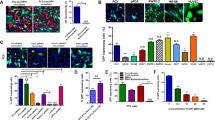Abstract
FMEV retroviral vectors combine the long terminal repeat of Friend mink cell focus-forming viruses with the 5′ untranslated leader region of the murine embryonic stem cells virus. These modules were connected to achieve high transgene expression in hematopoietic progenitor and stem cells. Here, we report the cloning of safety-improved and versatile FMEV vectors allowing module-wise exchange of crucial elements for comparative studies. By transfer and expression of four different marker genes (neomycin phosphotransferase, lacZ, enhanced green fluorescent protein and truncated low affinity nerve growth factor receptor), we formally demonstrate that both the long terminal repeat and the leader contribute to the high expression of FMEV in transduced hematopoietic cells. Most prominent are the data recorded in the absence of selection in myelo-erythroid progenitor cells. Here, FMEV vectors mediate up to two orders of magnitude increased transgene expression levels when compared with vectors based on the Moloney murine leukemia virus.
This is a preview of subscription content, access via your institution
Access options
Subscribe to this journal
Receive 12 print issues and online access
$259.00 per year
only $21.58 per issue
Buy this article
- Purchase on Springer Link
- Instant access to full article PDF
Prices may be subject to local taxes which are calculated during checkout
Similar content being viewed by others
Author information
Authors and Affiliations
Rights and permissions
About this article
Cite this article
Hildinger, M., Eckert, HG., Schilz, A. et al. FMEV vectors: both retroviral long terminal repeat and leader are important for high expression in transduced hematopoietic cells. Gene Ther 5, 1575–1579 (1998). https://doi.org/10.1038/sj.gt.3300759
Received:
Accepted:
Published:
Issue Date:
DOI: https://doi.org/10.1038/sj.gt.3300759
Keywords
This article is cited by
-
Retroviral gene therapy in Germany with a view on previous experience and future perspectives
Gene Therapy (2021)
-
OuaSelect, a novel ouabain-resistant human marker gene that allows efficient cell selection within 48 h
Gene Therapy (2007)
-
Rapid detection of retroviral vector integration sites in colony-forming human peripheral blood progenitor cells using PCR with arbitrary primers
Gene Therapy (2003)
-
Enhanced transgene expression in primitive hematopoietic progenitor cells and embryonic stem cells efficiently transduced by optimized retroviral hybrid vectors
Gene Therapy (2002)
-
Efficient marking of neural stem cell-derived neurons with a modified murine embryonic stem cell virus, MESV2
Gene Therapy (2002)



